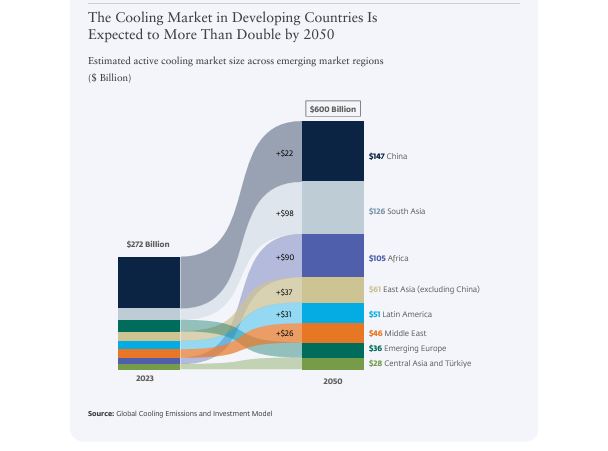- The market for sustainable cooling methods in growing economies is about to hit $600 billion by 2050. Analysis exhibits that sustainable cooling systems can lower cooling-related emissions by virtually 50%.
- They will additionally assist decrease electrical energy payments, scale back gear prices, and energy sector investments by $8 trillion by 2050.
- Unlocking finance, specifically non-public finance, is important to assist the transition to sustainable cooling throughout growing economies.
Economies in Africa are projected to expertise the quickest progress in cooling methods, a brand new survey by the Worldwide Finance Company and the UN Surroundings Programme (UNEP)-led Cool Coalition exhibits.
Globally, Africa is poised to see her cooling methods trade increase by an element of seven intently adopted by international locations in South Asia which is able to see this market phase quadruple.
“The sustainable cooling market represents a minimum of a 600-billion-dollar alternative for the non-public sector, which might generate greater than 8 trillion {dollars} in advantages for growing international locations,” mentioned Makhtar Diop, IFC’s Managing Director.
“These nations are particularly susceptible to the lethal results of rising temperatures and are urgently in want of cooling options. We’re proud to current this report which describes the chance to spend money on sustainable, inexpensive, and scalable cooling options, aiming for near-zero emissions by 2050.”
Cooling methods market progress projections
The UNEP-led Cool Coalition is a broad community that brings collectively governments, cities, worldwide organizations, companies, finance, academia, and civil society teams to facilitate data alternate, advocacy, and joint motion in direction of international transition to sustainable cooling. Presently, the Cool Coalition is working with over 130 companions, together with 23 international locations.
IFC and UNEP word that cooling methods market in growing economies is anticipated to develop from the present $300 billion to a minimum of $600 billion, per yr by 2050.
The examine, which was launched through the 79th UN international assembly in New York calls on economies and policymakers to prioritise using passive, energy-efficient, environmentally pleasant, and economically viable cooling options.
The Cooler Finance: Mobilizing Funding for the Creating World’s Sustainable Cooling Wants report notes that growing economies, which generate roughly two-thirds of world cooling-related emissions, are set to double their cooling demand by 2050.
In keeping with the researchers, this rise in cooling methods demand is attributable to an increase in inhabitants, enlargement of economies, and elevated urbanization, situations that are unravelling throughout Africa at breakneck velocity.
The report finds that sustainable cooling methods applied sciences may also help decrease cooling-related emissions by virtually half in 2050 in growing economies. Nonetheless, to understand these advantages, economies are suggested to contemplate deploying passive cooling methods comparable to insulation in power methods.
Different ideas that will likely be very important are rolling out using reflective supplies, enhancing inexperienced areas, whereas additionally adopting using energy-efficient applied sciences at scale.

Implementing minimal power efficiency requirements
Moreover, international locations and industries are suggested to maneuver with velocity in imposing minimal power efficiency requirements to understand decrease cooling-related emissions. What’s extra, the report notes that there’s must undertake and design recent constructing power codes.
A quicker part down of local weather warming refrigerants will even be useful to economies searching for to satisfy decrease cooling methods associated emission targets.
For worth chains throughout industries, a methods strategy to chilly chains and enormous cooling infrastructure companies will likely be important to understand these advantages. The report recommends using incentives to advertise innovation as a method of accelerating the tempo of this course of.
The report highlights the necessity for vital upfront investments. Closing current shortfalls in entry to cooling methods for households and SMEs in growing international locations would require roughly $400-800 billion, along with future will increase in demand.
“As file temperatures proceed to be damaged the world over, holding cool is an important want for each wholesome communities and a wholesome atmosphere. Nonetheless, we should keep away from making a vicious cycle of assembly cooling calls for via options that additional warmth up the planet,” mentioned Inger Andersen, Government Director of UNEP.
“We want sustainable, inexpensive and power environment friendly cooling options that each meet rising demand and assist local weather, well being, meals safety, and financial improvement. Governments, non-public companies, and multilateral banks can use this report back to harness a variety of economic devices for sustainable cooling and resilience to excessive warmth.”
Different key suggestions in accordance with the report will embody the gathering and collation of high quality knowledge on cooling methods. Capital prices, and financing will equally be important in realising the advantages of lesser cooling methods associated emissions.
Elevated seed and high-risk funding
Additional, elevating consciousness, increasing use of finest observe enterprise fashions and financing instruments will likely be very important on this journey. On the identical time, the report requires initiatives that can drive rising seed and high-risk funding for pilot applied sciences the world over.
Additionally welcome on this journey will likely be methods to reinforce leveraging blended and concessional finance; and constructing on the International Cooling Pledge to create a Sustainable Cooling Finance Partnership.
The transition to sustainable cooling methods requires an enabling atmosphere to make growing economies extra enticing to traders. UNEP and IFC mentioned they dedicated to working with governments, companies, and different stakeholders to de-risk investments and guarantee sustainable cooling options are accessible to all, particularly in low-income areas most vulnerable to more and more widespread heatwaves.
Learn additionally: Can Africa’s fragmented voice discover unity at COP29 local weather finance talks?